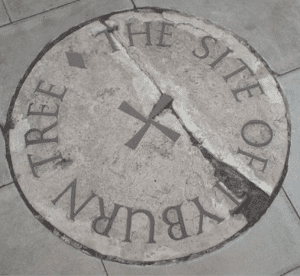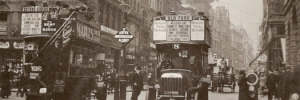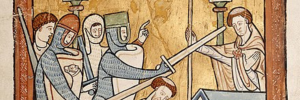Tens of thousands of people were publicly executed in London across one hundred sites. For centuries, the name Tyburn was synonymous with capital punishment, it being the principal place for execution of Londoners; criminals, traitors, and rebellious religious martyrs. It’s easy to forget that this once-busy location played an important role in our history. Today it’s largely forgotten albeit a plaque set into the pavement.

How did Tyburn get its name?
There are various theories pertaining to the origin of the name. The first syllable, ty, could be derived from the name of the Germanic god Tiw, who was the god of law or refer to the union of two streams, or two streams dividing to surround an area of land. The second syllable of the word is likely derived from burna, a word that refers to stream or brook, think Westbourne, Holborn and Marylebone.
The Tyburn gallows were originally located on the banks of the now-underground Tyburn Brook in Middlesex. The trees were situated within the north westerly bounds of what is now Hyde Park, on the corner of Marble Arch.
Tyburn could also have been called originally Teoburna, a stream referred to in the Charter of King Edgar in 951AD, in which case the word could mean ‘boundary stream.’ By the time the Domesday Book was written (1085), Tybourne had evolved to refer to the area now known as Marble Arch.
Elm trees were considered to be the tree of justice by the Normans who conquered England after the Battle of Hastings in 1066. Official sites of gallows, including Tyburn, were often simply referred to as ‘the Elms.’
See more explanation here: Elm, the tree of death
There were ‘Elms’ at both Tyburn and Smithfield in Medieval London, making it difficult to determine where exactly certain criminals were executed in the Middle Ages. The amount of available space at each of these sites was very different. Tyburn was the largest of London’s execution sites. It was far away from the City. Smithfield was considerably smaller and was only a couple of feet out of the City walls.



